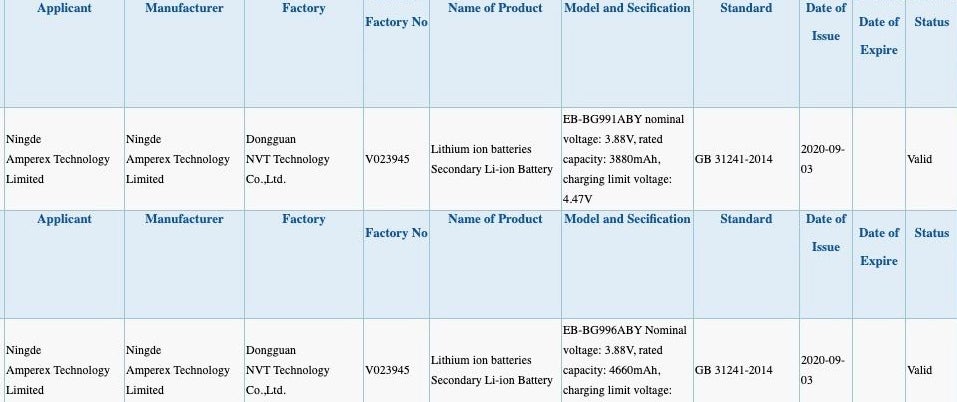The Galaxy S21/Plus/Ultra to have way better battery life than the S20 series, here's why
We may earn a commission if you make a purchase from the links on this page.

UPDATE: Reservations for the Galaxy S21 preorder are now open in the US. Get $50 in store credit for registering!
###
At first specs blush, the Galaxy S21 doesn't differ all that much from its S20 predecessor - same screen size, battery capacity and camera set. One look at the new S21 series design, however, what with its camera island blending in a seamless fusion with the side frame, and one starts to wonder if the differences under the hood are more than the specs sheet meets the eye, though. That is especially true when it comes to the battery life potential, and we are listing the S21 series advantages before their predecessors here.
Samsung Galaxy S21 battery life
- 4000mAh battery
- 1080p display vs 1440p on the S20
- Frugal 5nm chipset with integrated 5G modem vs 7nm and standalone on S20
- Next-gen 5G antenna isolation film
Take the battery unit of the S21, for instance whose model number is EB-BG991ABY, sound familiar? It is actually the 4000mAh EB-BG980ABY piece that is found inside the S20 as well, so battery life should be about the same, right? Well, not really, and here's why.

Galaxy S21 and S21+ rated battery capacities
The FHD (S21) vs QHD (S20) display
While the Galaxy S20 is equipped with an overkill 1440p resolution on a comparatively tall and narrow 6.2" screen, Samsung went the smarter route this time around, and is launching the S21 with a 1080p panel. The lower pixel density makes for a much more frugal panel, as there are 1MM+ less pixels to light up and manage with the graphics subsystem. Our own battery tests show that phones with FHD screens perform 20-30% better in terms of battery life than those with QHD or higher screen resolutions when we average out for the battery capacity difference.
Tap the lower band of that range, and the S21 should outlast the S20 with two hours, hitting a tenner in our browsing and scrolling battery test, all other things being equal. The point is they won't be equal, however.
The 5nm (S21) vs 7nm (S20) processor
Compared to the second-gen 7nm (7LPP) Snapdragon 865 processor in the S20, made in the TSMC foundry, the 5nm Snapdragon 888 is made using Samsung's new EUV process. The fact that Qualcomm not only switched nodes from 7nm to 5nm, but also the foundry itself , is a vote of confidence in Samsung's Extreme UltraViolet (EUV) lithography.
According to Samsung, its 5nm EUV process offers not only a fifth smaller footprint of the chipset at the same performance, but also about 20% smaller power draw. Alternatively, phone makers can choose to gain a 10% performance increase at the same battery consumption. Given that mobile chipsets are already powerful enough for anything you may throw at them, and the new X1 cores are clocked at the same 2.84GHz as the 865, Samsung is likely to go with the generous power consumption decrease.
The integrated (S21) vs standalone (S20) 5G connectivity
The 7nm vs 5nm process alone won't make a significant extra difference in battery life between the two phones, though, as the main power draw comes from the display. The phones' 5G connectivity battery draw, however, will, as maintaining a link to the 5G network is a battery hog. Why? Well, first off, before Snapdragon 888, only Huawei had integrated 5G system-on-a-chip (SoC) for flagship phones. Qualcomm made do with chipsets like the 765 in the Pixel 5 or LG Velvet, which, albeit having the 5G modem as an integral part of the chipset, are a far cry from its 8-series in terms of performance.
With Snapdragon 888, however, Qualcomm managed to finally do what it does best - pair the fastest ARM Cortex cores available with a new powerful Adreno 650 graphics AND fuse them with the X60 5G modem that is also made on the 5nm process. That alone amounts for a significant drop in power consumption when connected to a cell tower but Korean media just reported that there will also be improvements in the 5G antenna hardware.
Next-gen 5G antenna isolation
Fast 5G networks like Verizon's Ultrawide Band (UWB) mmWave can carry a lot of data at once and fast, but have very bad signal penetration that forces phone makers to slap a bunch of extra antennas all around their handsets just so that the signal can pass through your grip alone.
The Elec, however, is reporting that Samsung will use the next generation of low permittivity polyimide (PI) films for the 5G antennas in the Galaxy S21 phones. This means easier signal passthrough, and less toll on the battery. Taken individually, all these power draw improvements, with the exception of the lower pixel density, may not amount to much, but as a whole, should provide a healthy boost to the Galaxy S21 battery life from the same 4000mAh battery capacity.
Galaxy S21+ battery life
- 4800mAh battery vs 4500mAh in S20+
- 1080p display vs 1440p on the S20+
- Frugal 5nm chipset with integrated 5G modem vs 7nm and standalone on S21+
- Next-gen 5G antenna isolation film
For the 6.7" Galaxy S21+, Samsung went a slightly different route, perhaps because the S20+ sales were a surprise hit at launch. Not only will it ship with an FHD instead of QHD display resolution, too, just like the S21, but Samsung is using the larger body to also fit a larger battery compared to its predecessor.

The 4800mAh battery of the S21+ is bigger than the S20+ piec
Just 200mAh short of the giant 5000mAh battery in the S20 Ultra, the S21+ pack could catapult it to the top of the Galaxy S21 series battery life pile, as all other energy-saving components - 5nm chipset, integrated 5G modem and better antenna isolation - also apply to the S21+ as well.

Galaxy S21 Ultra battery life
- 5000mAh battery
- 1440p LTPO with dynamic 120Hz refresh vs 1440p LTPS w/ static 120Hz on S20 Ultra
- Frugal 5nm chipset with integrated 5G modem vs 7nm and standalone on S21 Ultra
- Next-gen 5G antenna isolation film
On first pass, the top-shelf member of the Galaxy S21 family - the S21 Ultra - would provide the same key power draw advantages we list in detail in the S21 section. It will also sport the 5nm Snapdragon 888 or Exynos 2100 processors with integrated 5nm 5G modems and new, more frugal antenna materials.
The key element for greater Galaxy S21 series battery life when compared to the S20 models - FHD instead of QHD display resolution - however, is missing from the equation. Given that the S21 Ultra is flaunting the same 5000mAh battery piece as the S20 Ultra, and the same high display pixel density, the only battery life gains compared to its predecessor should come from the 5nm chipset and 5G antennas, right?
Well, not really, as this time around, its QHD display will be of the more frugal LPTO variety, not the LTPS panel with static 120Hz refresh found in the S20 Ultra, and that alone would amount to a 15-20% diminished power draw. When we add the dynamic refresh rate that LTPO allows which only uses 120Hz when it matters - i.e. when browsing and scrolling, or during interface animations - the battery savings may be as significant as having a lower-res display.
This article says 6.8" 144Hz on the Ultra and asks about LTPO. We can confirm LTPO as well as 6.8", we think 120Hz with one other exciting feature...https://t.co/OFdefsYeFb
— Ross Young (@DSCCRoss) October 28, 2020
Still, given the increased S21+ battery capacity, it will be very interesting to test if the S21 Ultra model will beat the others in battery life just like its predecessor last year did. What do you think?
Follow us on Google News













Things that are NOT allowed:
To help keep our community safe and free from spam, we apply temporary limits to newly created accounts: